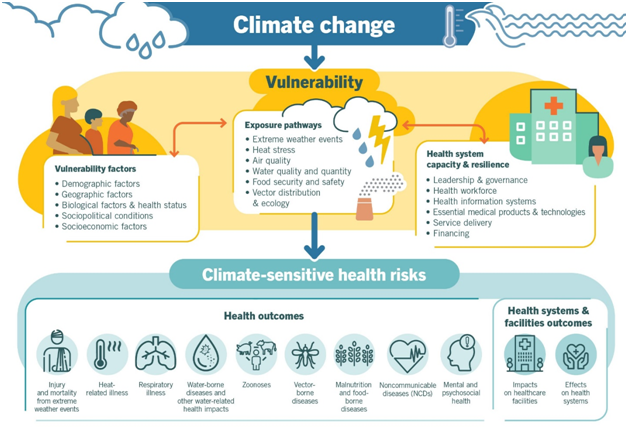

16th November 2022 (6 Topics)
Context
Even as countries are meeting at the ongoing Climate Change Conference (COP27) in Egypt, a recent report by Lancet, has traced in detail the intimate link between changing weather events and their impact on the health of people.
About
What does the report outline?
The ReportThe 2022 Lancet Countdown on Health and Climate Change: Health at the Mercy of Fossil Fuels points out that the world’s reliance on fossil fuels increases the risk of disease, food insecurity, and other illnesses related to heat. |
- Climate change is not an isolated incident or occurrence, but a global phenomenon.
- Persistent fossil fuel overdependence has pushed the world into global energy and cost-of-living crises.
- Rapidly increasing temperatures have exposed people, especially vulnerable populations 3.7 billion more heatwave days in 2021 than annually in 1986–2005.
- Health-focused shifts in dietary habits would reduce the burden of communicable and non-communicable diseases.
How climate change is impacting health?
Climate change is already impacting health in a myriad of ways, including by
|
The coastal waters are becoming more suited for the transmission of Vibrio pathogens. The number of months suitable for malaria transmission has increased in the highland areas of the Americas and Africa. |
- leading to death and illness from increasingly frequent extreme weather events, such as heatwaves, storms, and floods
- disruption of food systems
- increases in zoonoses and food-, water- and vector-borne diseases, and mental health issues
- Undermining of social determinants for good health (livelihoods, equality, and access to health care and social support structures)
Who are the most affected?
- The climate-sensitive health risks are disproportionately felt by the most vulnerable and disadvantaged, including women, children, ethnic minorities, poor communities, migrants or displaced persons, older populations, and those with underlying health conditions.

Are there any solutions?
- A health-centered response to climate and energy crises
- It would reduce the likelihood of the most catastrophic climate change impacts.
- Improve energy security.
- Improvements in air quality will help prevent deaths(from fuel-derived PM2.5)
- Create an opportunity for economic recovery.
- An increase in urban spaces would result in promoting physical activity.
- Plant-based diets will reduce emissions from red meat and milk production
- Positive signs:
- Rising coverage of health and climate change in the media.
- Government's commitment to assess and address the threats from climate change.
India’s case:
- In 2019, 17.8% of all deaths and 11.5% of respiratory, cardiovascular, and other related diseases are attributable to high exposure to pollution (The Lancet).
- The isolated nature of policymaking and an insufficient understanding of health among policymakers is worrying.
- India has to place health at the center of air quality governance and policymaking.
National Clean Air Programme (NCAP):
- It was launched by the Ministry of Environment, Forests and Climate Change (MoEFCC) in January 2019.
- It aims to bring a 20%-30% reduction in pollution levels from PM2.5 and PM10 particles by 2024, using 2017 pollution levels as a base.
- It is the first-ever effort in the country to frame a national framework for air quality management with a time-bound reduction target.
- It covers 132 non-attainment cities which were identified by the Central Pollution Control Board (CPCB).
| Non-attainment cities: This is defined as a city whose air quality did not meet the national ambient air quality standards from 2011 to 2015. |
Initiatives taken by India for Controlling Air Pollution:
- System of Air Quality and Weather Forecasting and Research (SAFAR) Portal
- Air Quality Index: AQI has been developed for eight pollutants viz. PM2.5, PM10, Ammonia, Lead, nitrogen oxides, sulphur dioxide, ozone, and carbon monoxide.
- Graded Response Action Plan (for Delhi)
- For Reducing Vehicular Pollution:
- BS-VI Vehicles,
- Push for Electric Vehicles (EVs),
- Odd-Even Policy as an emergency measure (for Delhi)
- New Commission for Air Quality Management
- It is a statutory authority - the Commission for Air Quality Management in National Capital Region (NCR) and Adjoining Areas.
- The MoEFCC brought a second ordinance in April 2021, after farmers had raised concerns about stiff penalties and possible jail terms for stubble burning.
- Subsidy to farmers for buying Turbo Happy Seeder (THS) Machine for reducing stubble burning.
- National Air Quality Monitoring Programme (NAMP):
- Under NAMP, four air pollutants viz. SO2, NO2, PM10, and PM2.5 have been identified for regular monitoring at all locations.
WHO’s New Air Quality Guidelines:
|
More Articles



